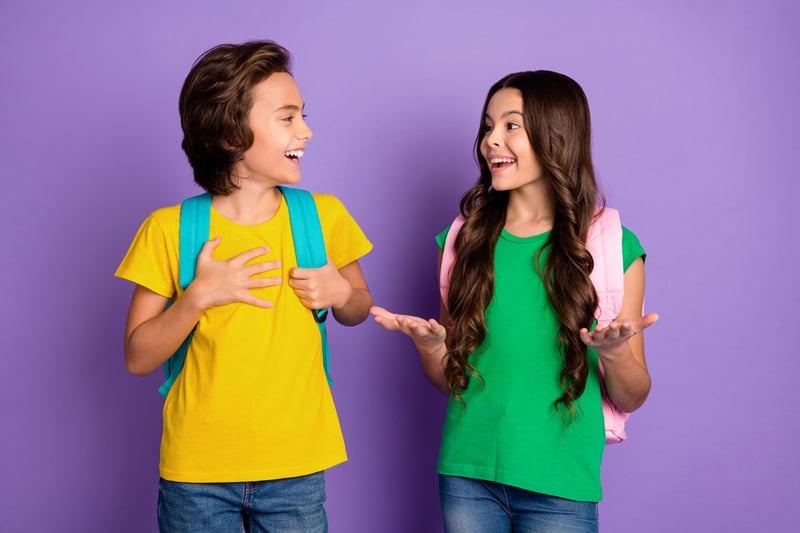
I’ve never been great at small talk. It is only when I can burrow beneath surface-level chit-chat level that I become truly engaged.
I am, however, considerably more advanced at the art of polite conversation than my children. My boys are either too direct (eg “My grandad’s losing his hair too”) or shy and monosyllabic, mumbling to their shoes when spoken to by someone unfamiliar. Even in writing, they can struggle with self-expression. “Dear Nana,” emailed my eldest, after the death of my father-in-law, “I’m sorry that your husband died”. He wasn’t being deliberately insensitive. He was trying to sound ‘grown-up’ as he typed through his tears.
Show-and-tell opportunities in the classroom have improved my kids’ confidence and presentation skills – they are great at addressing a crowd. But the art of conversation is a skill rarely taught … unless you are a posh young lady at finishing school in Switzerland (which doesn’t apply to anyone I know!).
So how do we raise our children to be confident conversationalists? It’s something we’ve been working on at home with our own kids. While we still have a long way to go, I thought I’d share a few of the things we’ve learnt so far ….
Modelling and repetition
We learn our first words and phrases by listening and copying. Infants whose parents spend lots of time talking to them tend to start talking earlier and have larger vocabularies.
When I lived in France, I found that my French improved considerably by having the same conversations – or types of conversations - over and over again: Talking about the weather while waiting at the bus stop; discussing the opening of the new theatre in town; talking about music to my new French friends. I would pay attention to people’s responses and the phrases they used and then try them out in the next similar conversation I had.
Children learn to communicate and converse in a similar way - by observing and copying. It is important for them to be able to sit in on grown-up conversations to see how they ‘work’ and not be constantly shooed away or handed a mobile device to keep them quiet. My husband and I seek out opportunities for our kids to listen and speak to a variety of people.
These include:
- Family discussions at the dinner table
- Getting the kids to order everyone’s meals when we go out for dinner (waiting staff almost always try to engage them in conversation when they do)
- Paying for things in shops – eye contact, please and thank yous, simple stuff
- Introducing them to people of different ages at church and encouraging them to say something (anything) to new kids at Sunday School to make them feel welcome
- Skyping and phoning their grandparents in the UK independently
- Encouraging them to chat with other kids who play in our street
- Teaching them how to introduce themselves to people
Curiosity
We try to encourage our children’s natural curiosity and interest in others. Children’s conversations tend to revolve around themselves and their own interests. Developing empathy and an interest in others is essential to keeping a conversation going. We challenge our boys to find out things about other kids in their class like:
- Who has a pet?
- Who plays a musical instrument?
- Who speaks another language?
- Who lives near us?
- Who has a sibling in the same year as yours?
Body language
It is difficult to insist on a four-year-old looking into the eyes of the person talking to him when he has to tilt his head way back to do so. However, we do remind our children to maintain eye contact when they speak to others, even when just saying ‘please’ or ‘thank you’. Fidgeting, slouching and looking around when talking also suggests a level of distraction and disinterest.
Electronic devices
I used to volunteer at an inner-city youth club in London where awkward, shuffling teenagers would converse with each other by text on their mobile phones as they sat shoulder-to-shoulder in silence. Lng liv the Rt of cnvstn! That was ten years ago.
Today, we’re even more likely to send an email or text or post a message online than pick up a phone and have a conversation or even – gasp! - speak to someone face-to-face. It is not entirely unheard of in my house to have the TV on, be reading something on a laptop and discussing what we will be doing at the weekend. SIMULTANEOUSLY. Oh dear.
If we want our kids to develop their conversation skills, we all need more time away from electronica and ‘virtual’ conversations. We need to talk to our children without the distraction of a screen or the background buzz of a television. We need to look at them as we speak and give them a little undivided attention – they need to see the whites of our eyes! Instead of constant texting and Instagramming, we can encourage our children to phone their friends or take the time to drive them round to friends’ houses if it’s not possible for them to walk there.
Games
It can take a lot of courage and confidence for kids to initiate and participate in conversation with others. At home we enjoy a few silly games help our boys explore different forms of social interchange:
Role-play
Role-play and drama games have provided much hilarity in our house, giving my kids the opportunity to practice ‘talking to the Queen’, conduct pretend business meetings, ask an alien all about his home planet and communicate with people in made-up languages. The practical application of these skills may not be immediately obvious but it is challenging them to think about how and why they engage with others.
The ‘Why?’ game
I am trying to show my kids why it is good to ask ‘open-ended’ questions that cannot be answered by a simple ‘yes’ or ‘no’ (just as I encourage them to avoid answering questions in binary). This is a difficult game for littlies but it forces kids to think about how we use questions in our day-to-day. The rules are very simple: This is a game for two people. Participants are only allowed to speak in questions. If you do not frame your answer within another question, you lose. For example, the dialogue might go like this:
“Why are you wearing that coat?”
“Why do you want to know?”
“Is it raining outside?”
“Why don’t you go and look?”
“Don’t you think I’ve got enough to do?”
“Couldn’t you ask Dad to help?”
“Where is Dad?”
“How would I know?” etc
The Art of (Children's) Conversation
 www.taoc.com.au/taocchildrens.html
www.taoc.com.au/taocchildrens.html
My Auntie sent us this for Christmas (she obviously thought we needed it!) and we’ve been playing it a little at the end of each family meal. It’s a very simple concept: The ‘game’ consists of a pile of cards with conversation topics written on them, such as “If you could choose your own name, what would it be?” or “What’s your idea of a perfect day?”. Someone picks a card and asks the question of another player. Once that player has answered the question, the other players can probe further by asking additional questions, eg “’Flora’? That’s an interesting name. Where did you first hear that? What name would you like if you were a boy?” etc. Blank cards are included in the set for writing your own conversation openers.
How are you encouraging your children's conversation skills? Let's talk about it ...










